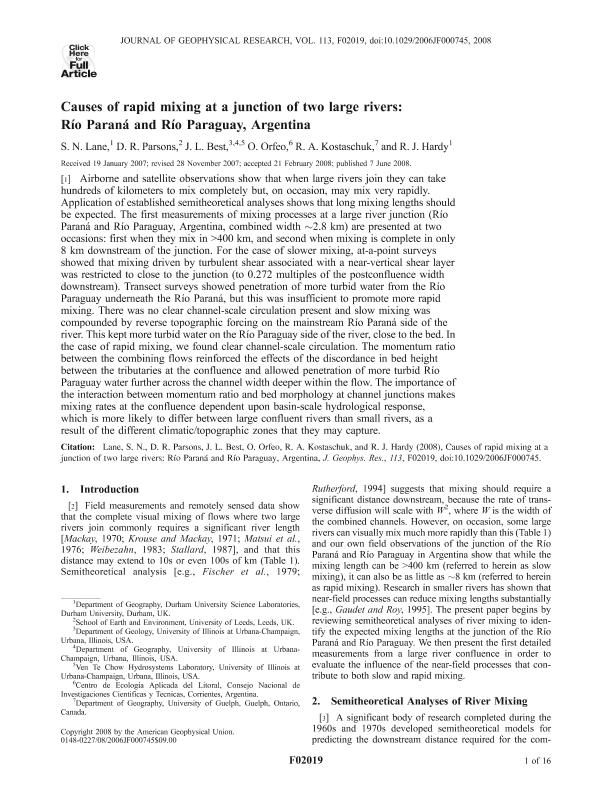Artículo
Causes of rapid mixing at a junction of two large rivers: Río Paraná and Río Paraguay, Argentina
Lane, Stuart N.; Parsons, Daniel R.; Best, James L.; Orfeo, Oscar ; Kostaschuk, R. A.; Hardy, Richard J.
; Kostaschuk, R. A.; Hardy, Richard J.
 ; Kostaschuk, R. A.; Hardy, Richard J.
; Kostaschuk, R. A.; Hardy, Richard J.
Fecha de publicación:
06/2008
Editorial:
Blackwell Publishing Ltd
Revista:
Journal of Geophysical Research: Earth Surface
ISSN:
2169-9011
Idioma:
Inglés
Tipo de recurso:
Artículo publicado
Clasificación temática:
Resumen
Airborne and satellite observations show that when large rivers join they can take hundreds of kilometers to mix completely but, on occasion, may mix very rapidly. Application of established semitheoretical analyses shows that long mixing lengths should be expected. The first measurements of mixing processes at a large river junction (Río Paraná and Río Paraguay, Argentina, combined width ∼2.8 km) are presented at two occasions: first when they mix in >400 km, and second when mixing is complete in only 8 km downstream of the junction. For the case of slower mixing, at-a-point surveys showed that mixing driven by turbulent shear associated with a near-vertical shear layer was restricted to close to the junction (to 0.272 multiples of the postconfluence width downstream). Transect surveys showed penetration of more turbid water from the Río Paraguay underneath the Río Paraná, but this was insufficient to promote more rapid mixing. There was no clear channel-scale circulation present and slow mixing was compounded by reverse topographic forcing on the mainstream Río Paraná side of the river. This kept more turbid water on the Río Paraguay side of the river, close to the bed. In the case of rapid mixing, we found clear channel-scale circulation. The momentum ratio between the combining flows reinforced the effects of the discordance in bed height between the tributaries at the confluence and allowed penetration of more turbid Río Paraguay water further across the channel width deeper within the flow. The importance of the interaction between momentum ratio and bed morphology at channel junctions makes mixing rates at the confluence dependent upon basin-scale hydrological response, which is more likely to differ between large confluent rivers than small rivers, as a result of the different climatic/topographic zones that they may capture.
Palabras clave:
Mixing
,
Junction
,
Paraná
,
Paraguay
Archivos asociados
Licencia
Identificadores
Colecciones
Articulos(CECOAL)
Articulos de CENTRO DE ECOLOGIA APLICADA DEL LITORAL (I)
Articulos de CENTRO DE ECOLOGIA APLICADA DEL LITORAL (I)
Citación
Lane, Stuart N.; Parsons, Daniel R.; Best, James L.; Orfeo, Oscar; Kostaschuk, R. A.; et al.; Causes of rapid mixing at a junction of two large rivers: Río Paraná and Río Paraguay, Argentina; Blackwell Publishing Ltd; Journal of Geophysical Research: Earth Surface; 113; 2; 6-2008; 1-16
Compartir
Altmétricas



